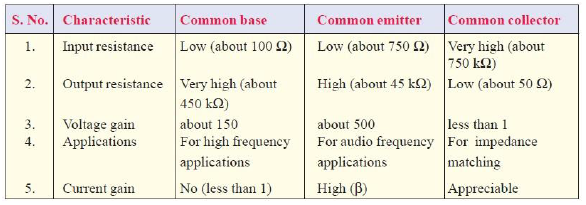The comparison of various characteristics of the three connections is given below in the tabular form.
The following points are worth noting about transistor arrangements

(i) CB Circuit. The input resistance (r
i) of CB circuit is low because I
E is high. The output resistance (r
o) is high because of reverse voltage at the collector. It has no current gain (a < 1) but voltage gain can be high. The CB circuit is seldom used. The only advantage of CB circuit is that it provides good stability against increase in temperature.
(ii) CE Circuit. The input resistance (r
i) of a CE circuit is high because of small I
B. Therefore, ri for a CE circuit is much higher than that of CB circuit. The output resistance (r
o) of CE circuit is smaller than that of CB circuit. The current gain of CE circuit is large because I
C is much larger than I
B. The voltage gain of CE circuit is larger than that of CB circuit. The CE circuit is generally used because it has the best combination of voltage gain and current gain. The disadvantage of CE circuit is that the leakage current is amplified in the circuit, but bias stabilisation methods can be used.
(iii) CC Circuit. The input resistance (r
i) and output resistance (r
o) of CC circuit are respectively high and low as compared to other circuits. There is no voltage gain (Av < 1) in a CC circuit. This circuit is often used for impedance matching.
Wilfykil answered the question on
August 15, 2019 at 05:40